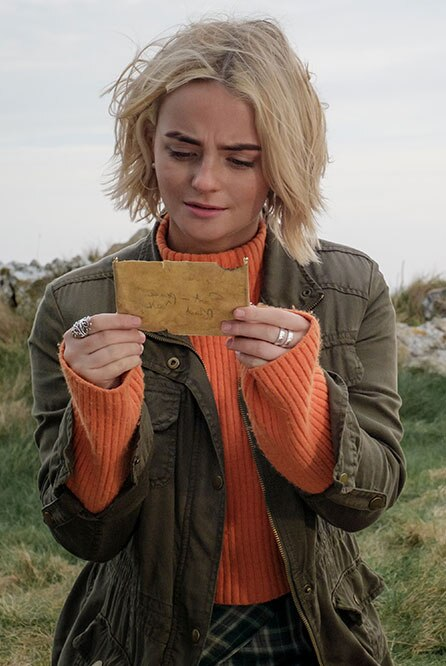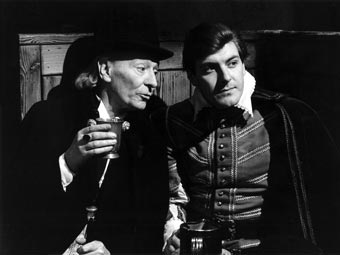This Saturday’s Doctor Who episode, 73 Yards, looks set to be a major deviation from most Who episodes – the Doctor doesn’t seem to play a huge role at all. This is due to Ncuti Gatwa finishing his other projects, but in-universe, it means that in contrast to Boom, this week will focus entirely on Millie Gibson and Ruby Sunday.
The “Doctor-lite” was a recurrence during Russell T Davies’ first era, with Love and Monsters and Blink removing the main cast entirely, whilst Midnight and Turn Left split the regulars up into their episodes. This was so other episodes could be filmed at the same time, and they’re certainly memorable episodes (if not entirely successful in Love and Monsters’ case!)
Since then, there have been some “mild” examples of double banking the regular casting, such as The Girl Who Waited and Flatline locking the Doctor up in the TARDIS whilst Matt Smith and Peter Capaldi filmed Closing Time and Mummy on the Orient Express respectively, and it’s this type of Doctor lite I THINK might be happening. Even the spin-offs did these types of episodes – Sarah Jane Adventures gave Elisabeth Sladen a story off every season, Torchwood split episodes between Gwen and the rest of the team as a double bank… even Class did it! Welcome to British TV!
BUT… what if I told you that removing the Doctor from the story, as a narrative device to overcome production difficulties, did NOT start in 2006? 40 years previously, a quietly revolutionary story became the template for the revival… or at least it would if a single frame of it survived.
Broadcast across February 1966, The Massacre of St Bartholomew’s Eve (or The Massacre for pedants) is one of many Hartnell pure historicals, and whilst I won’t talk too much about the story itself as I’m planning to rank all the televised pure historicals after I’ve caught up with all the recons of missing episodes, I will talk about how a single narrative choice changed everything about Doctor Who formula.
Even without aliens, the pure historicals were still at the end of the day the Doctor and his companions landing in history and having wacky adventures, from the Doctor and Vicki having slapstick adventures in Rome to Marco Polo wanting to gift the TARDIS to Kublai Khan. They varied in tone, but were still adventures with everyone’s favourite Time Lord and co. The Massacre changed EVERYTHING, and was such a divisive experiment at the time that it was one of the factors that killed off the pure historicals and was never repeated again in Classic Who.
With a new producer, constantly changing co-stars and his health deteriorating, William Hartnell had to be worked around in Season 3. Mission to the Unknown, the season’s second story, was a Dalek cutaway setting up Master Plan without any of the regular cast at the time, and when the Doctor does participate in the plot (following a Trojan side-quest) he is also regularly sidelined as the toll of the 12 parter was affecting Hartnell. Thus, Steven and Sara Kingdom take the lead at points, being the action stars to the Doctor’s wise sage. Sara Kingdom is killed off because John Wiles had no idea what to do with the female companion (could’ve just kept Maureen O’Brien but hey, what do I know) and thus, we have Steven, for the first time ever, as the sole companion for the story.
So now, The Massacre, a pure historical from John Lucarrotti (but really Donald Tosh) and it was decided to once again give Hartnell time off… with a twist. Being keen to play a villain, Wiles and Tosh let him play the Abbot of Amboise, one of the story’s main antagonists. As technology and scheduling was limited at the time, this meant writing out the Doctor. So in Episode One, the Doctor walks off, leaving Steven in a pub… and doesn’t return until the final episode. To such an extent that for the middle two episodes, there is no one credited for playing the Doctor. It’s like he’s left the show and Steven is now the powerless main character who can only observe.
Even the Abbot himself is only in a few scenes, so it’s Steven and Peter Purves’ time in the spotlight. Never before had a story had only one companion, and never before had the companion been the unambiguous main character to this level to the point where the Doctor’s plot isn’t even followed (it’s a popular fan theory this is when he was kidnapped in Five Doctors). The following few days for Steven are him as a literal fish out of water, slowly losing his faith in the Doctor, in a character piece that slowly builds to the titular massacre. I’ll focus more on why I love it as a story when I rank the pure historicals, but for 1966, the production team, whether by accident or by choice, created a new way to tell Doctor Who – tell it through the eyes of the companion.
Classic Doctor Who had the Doctor as the unambiguous main character, but for four weeks, it was Steven, the man out of time who goes from plucky comic relief to dramatic leading man within the span of a season. From the tail end of Classic Who going into the revival, the companion has shared equal focus to the Doctor, with Ace, Rose, Martha, Donna, Amy, Clara, Bill and the fam all leading narratives and being main characters in their own right. I don’t think this is ALL due to an obscure oddity from 1966 that lost audiences over the four weeks and was so totally out of left field that the incoming team decided to just jettison the format entirely, but The Massacre proved to be heavily vindicated over time, being ahead of the curve when it came to making the companion a layered character with which the audience can view the Doctor in a new light.
And not a single SECOND of footage is available.
Now, nearly 60 years later, the companion is once again waiting for the Doctor in a pub. What will transpire in 73 Yards? I don’t know, but if it’s anything as brutal or powerful as The Massacre or Turn Left, we’re in for something great.



